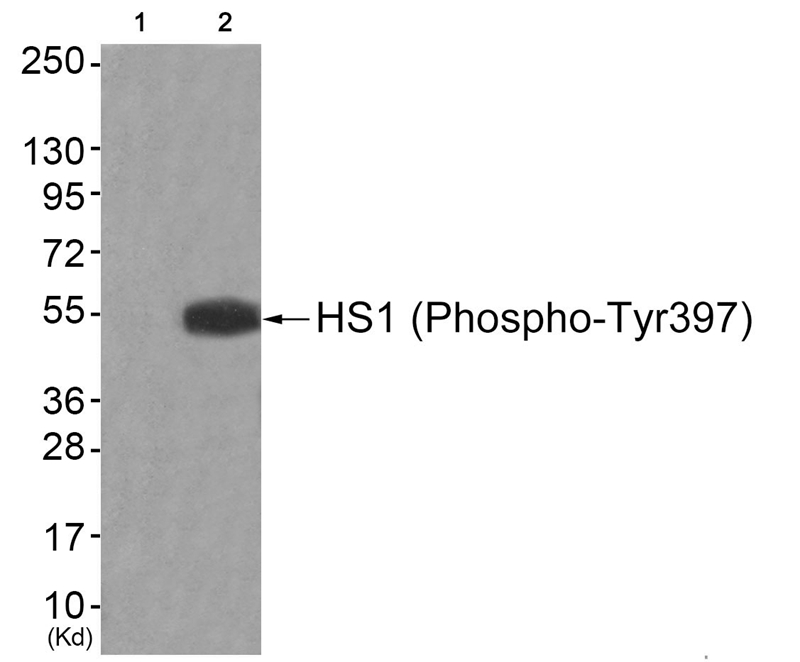
| WB | 咨询技术 | Human,Mouse,Rat |
| IF | 咨询技术 | Human,Mouse,Rat |
| IHC | 咨询技术 | Human,Mouse,Rat |
| ICC | 技术咨询 | Human,Mouse,Rat |
| FCM | 咨询技术 | Human,Mouse,Rat |
| Elisa | 咨询技术 | Human,Mouse,Rat |
| Aliases | HCLS1; LCKBP1; Hematopoietic cell- specific LYN substrate 1; |
| Entrez GeneID | 3059; |
| WB Predicted band size | 54kDa |
| Host/Isotype | Rabbit IgG |
| Antibody Type | Primary antibody |
| Storage | Store at 4°C short term. Aliquot and store at -20°C long term. Avoid freeze/thaw cycles. |
| Species Reactivity | Human |
| Immunogen | Peptide sequence around phosphorylation site of tyrosine 397(G-D-Y(p)-E-E) derived from Human HS1 . |
| Formulation | Purified antibody in PBS with 0.05% sodium azide. |
+ +
以下是关于HS1 (Phospho-Tyr397)抗体的3篇文献摘要信息:
---
1. **文献名称**: *"HS1 promotes T cell receptor-mediated signal transduction via interaction with Lck and ZAP-70"*
**作者**: Kitamura D. et al.
**摘要**: 该研究利用Phospho-Tyr397抗体发现,HS1在T细胞活化过程中通过Tyr397磷酸化与Lck和ZAP-70激酶相互作用,促进下游信号传导和免疫突触形成。实验表明,该磷酸化位点对T细胞受体(TCR)触发的细胞骨架重组至关重要。
---
2. **文献名称**: *"Phosphorylation of HS1 by Btk regulates B cell antigen receptor-induced actin remodeling"*
**作者**: Watanabe S. et al.
**摘要**: 研究通过HS1 (Phospho-Tyr397)抗体检测发现,B细胞受体(BCR)激活后,Bruton酪氨酸激酶(Btk)直接磷酸化HS1的Tyr397位点,进而调控肌动蛋白动态变化和B细胞抗原呈递功能。该磷酸化事件为B细胞活化提供了分子机制基础。
---
3. **文献名称**: *"Role of HS1 tyrosine phosphorylation in invadopodium formation and extracellular matrix degradation in cancer cells"*
**作者**: Yamaguchi H. et al.
**摘要**: 该研究使用Phospho-Tyr397抗体证明,HS1在肿瘤侵袭伪足(invadopodia)形成中起关键作用。Src激酶介导的Tyr397磷酸化增强了HS1与Arp2/3复合体的结合能力,促进细胞外基质降解及肿瘤转移。
---
**备注**:若需具体文献来源或更多信息,建议通过PubMed或Web of Science检索上述标题关键词,或关注《Blood》《Journal of Cell Biology》等期刊的相关研究。
The HS1 (Hematopoietic lineage cell-specific protein 1), also known as HCLS1. is a cytoskeletal protein predominantly expressed in hematopoietic cells. It plays a critical role in regulating immune cell functions, including cell migration, adhesion, and receptor signaling. Phosphorylation at tyrosine 397 (Tyr397) is a key post-translational modification of HS1. triggered by activation of immunoreceptors such as B-cell receptors (BCR) or T-cell receptors (TCR). This phosphorylation event facilitates interactions with downstream signaling molecules, notably the Src homology 2 (SH2) domain-containing kinases like Syk, which propagate intracellular signaling cascades essential for immune responses.
The HS1 (Phospho-Tyr397) antibody specifically detects HS1 when phosphorylated at Tyr397. serving as a valuable tool for studying immune cell activation and signaling dynamics. Researchers use this antibody in techniques such as Western blotting, immunoprecipitation, and flow cytometry to investigate HS1's role in lymphocyte development, antigen recognition, and pathological conditions like immunodeficiency disorders or hematological malignancies. Its specificity enables insights into how dysregulated HS1 phosphorylation contributes to disease mechanisms, including leukemias and lymphomas, where aberrant signaling pathways are often implicated. This antibody thus bridges molecular insights with clinical research in immunology and oncology.
×